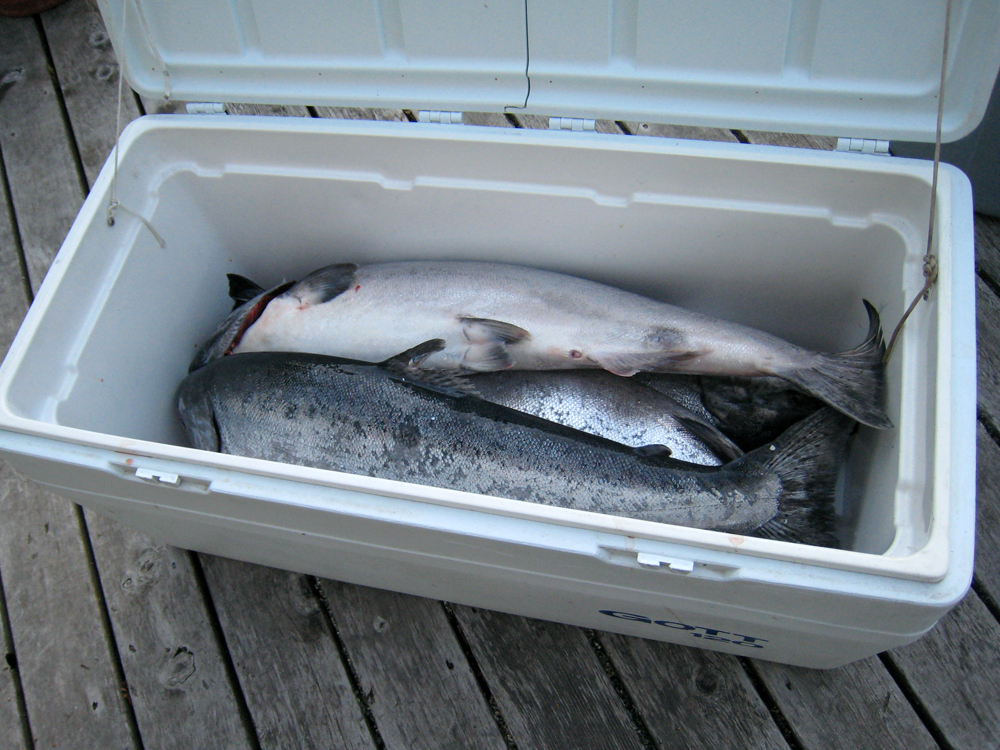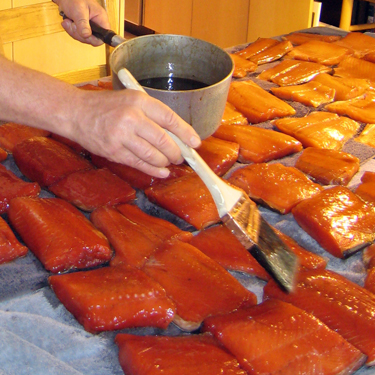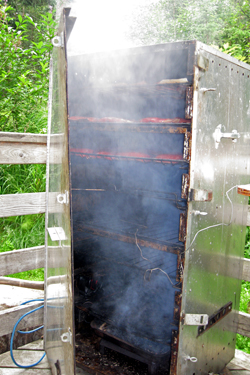home | meat grinders | sausage
stuffers | sausage casings | e-mail
SausageMania | NEW! Sausage Photo
Tutorial | sausageMania recipes |more
SausageMania recipes | motorize
a grinder | tips | links | kippermania | loxmania | NEW! PestoMania | NEW! Even MORE SausageMania Recipes! | NEW! Lox Making Photo Tutorial | NEW! CaviarMania | NEW! Porcini Sausage!

Learn How to Make Delicious Salmon Lox at Home! SausageMania will reveal all the closely-held secrets for making perfect lox, secrets that you've not found elsewhere on the Web, or otherwise you wouldn't be reading this page!
Lox
(or lachs) is salt-cured salmon that is
essentially raw, never having been raised to more than 85° F.
during processing. Lox recipes are difficult to find, as Lox Makers tend
to guard them as jealously as
the Masons have guarded their secret rites for centuries. One reason for such secrecy is to keep prices high. But here on LoxMania,
all is revealed! LoxMania'sLox Recipe been tried and tested for
over twenty
years!
Most Commerical Lox is made from farmed salmon raised in Norwegian fjords. Wild salmon are fast-swimming Muscle Fish: they swim thousands of miles back and forth across oceans, some for as long as seven years, before returning to their natal rivers and streams. Their constant, highly-charged rapacious activity, plus their natural diet of wild, free-swimming baitfish, confer a unique flavor, color, texture and taste to their meat.
Farmed Salmon, on the other hand, are penned up in aquatic cages of plastic mesh, get essentially no exercise and are fed pellets of processed fish meal and fish oil extracted from bottom feeders, so the meat of farmed salmon is soft, pale and bland: farmed salmon are the couch potatoes of the salmon world — flabby, dull and boring. In Alaska we refer to them as MacSalmon.
SausageMania will show you how to make Wild Salmon Lox. Yes, you can use farmed salmon if you cannot get hold of wild, but that option is simply not available to us in Alaska, where the sale of farmed salmon is illegal. Consequently, here in Alaska we must settle for wild salmon! >Sob!<
[NOTE: A NEW Lox Making Photo Tutorial can be found HERE.]
Some
lox is smoked and some lox is treated with dill and other herbs (so-called
gravadlax or gravlax). The recipe given here is for very lightly smoked lox made of Alaska
Silver salmon: the only ingredients are the salmon itself, salt, brown sugar
and dark rum. The
challenging steps here are in brining and "freshening" the product
to the right degree of saltiness, rehydration and consistency. None
of the other steps has to be perfect.
• Fillet
the salmon, but leave the skin side intact. Cut into serving
size pieces.
• Score the skin side with a razor
blade in parallel cuts (to allow the salt-sugar mix to be absorbed). Don't
cut the flesh — only the skin!
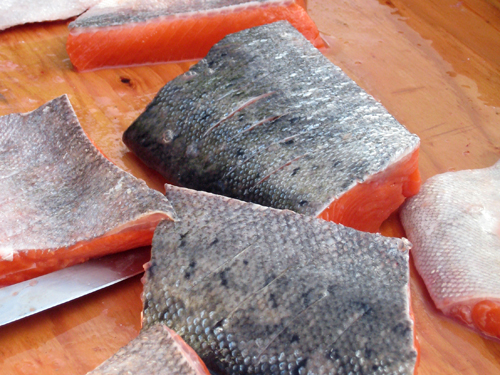
Scored King Salmon Fillets |
• Prepare a dry mix in the proportion of 3 parts coarse
salt to 4 parts brown sugar. Avoid iodized salt.
• Sprinkle a layer of the
salt-sugar mix on the bottom of a glass/plastic/stainless steel/porcelain
tray or bin (never aluminum).
• Make a layer of
the filleted pieces, cover with the salt-sugar mix, put
another layer on, and so forth, until the bin/tray is filled. Put more mix
on the thicker pieces, less on the thinner pieces. Sorry... can't quantify
any better than this. It's just a matter of learning.... I call it "differential
salting."
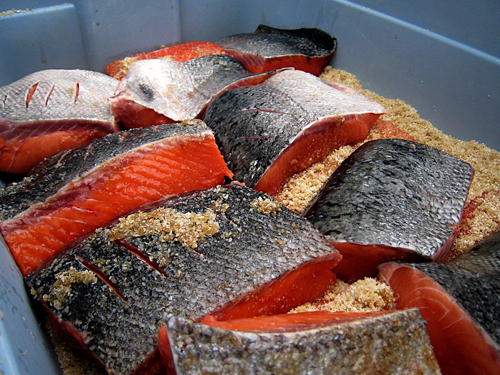
King Salmon Fillets in Salt-Sugar Mix |
• Let the bin sit for 12 hours. Lots
of syrupy liquid will appear (as the salt and sugar draw water from the fish).
As the salt and sugar pretty much stop any decomposition, the bin need not
be refrigerated, but try to keep it in a cool, shady place.
• Prepare a brine solution by mixing about 5-1/4 lbs. of coarse
salt to two gallons of water. A clean 5-gallon plastic bucket is ideal. Technically speaking, you want a 90% "salinometer brine," to be exact, as different salts produce different salinity, weight for weight. They shouldn't, if they are pure NaCl, but they do. So you might want to invest in a salinometer or salometer. You can get one from Amazon.com for about $25.00, free delivery.

A Salometer or Salinometer. A useful tool for lox making (also good if you are brining hams). |
•
Remove the pieces and briskly rinse off
any salt-sugar mix that remains with cold running water.
• Add the pieces to the brine solution and let sit for 12
hours. Pieces more than an inch thick need 18-24 hours. Does not need refrigeration. Brining draws water from the
fish as it cures the
salmon fillets. Lox is a cured food product and must never be heated. Brining is
a critical step of the process!
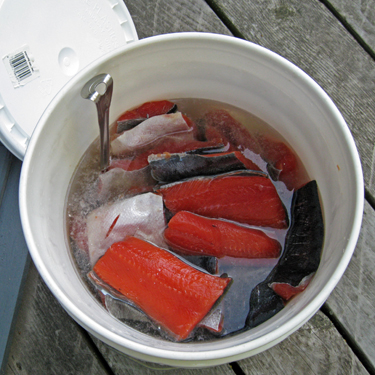
King Salmon Fillets in Brine Solution |
• Empty
the brine from the bucket and place a garden hose at the
bottom of the bucket. For details, please go to the LoxMania Photo Tutorial. Slowly run cold water through the hose, causing
the bucket
to overflow. This will begin to desalt,
or "freshen" the fish. Freshening is also a critical step! After an hour, remove one
of the thinner pieces, dry it off, test it for "sliceability" and
taste it to make sure sufficient salt has been removed. This is strictly
a matter
of judgment! Thicker pieces may take two or three hours to freshen. If you
over-freshen, the fish will become pale and waterlogged and those pieces
will
be ruined.
• As you remove the pieces, place them skin side down, on
a large towel on a table.
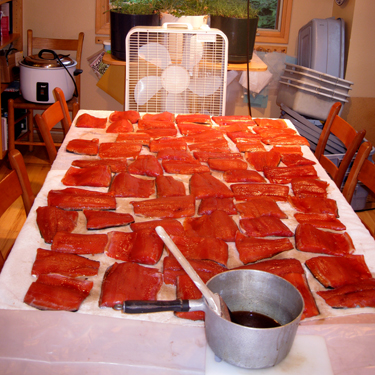 |
• Prepare a syrup of brown sugar and dark rum...... say, two
pounds of sugar to a fifth of rum..... pretty thick.... you may have to heat
it to dissolve the sugar. Use a full-bodied, dark rum such as Myers or Coruba.
• Brush the syrup onto each piece. Set a fan at the end of
the table where the fish is laid out. As the syrup is absorbed, brush on
a new layer. Do this for 5-6 hours until a pellicle (or "skin") of
syrup forms on the surface of the fish.
• Then, put the pieces in a smoker, and
lightly smoke for about 30-60 minutes.... with hickory, alder, cherry, apple....
anything but mesquite. Do not let the temperature
of the product rise above 85° F., or those pieces will be ruined!
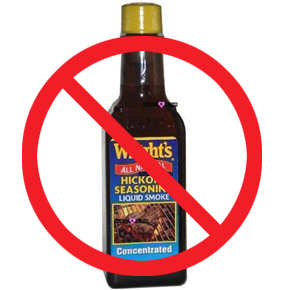
A Big No-No: Liquid Smoke. Your Salmon Deserves REAL Smoke! |
• Remove the pieces from the smoker, pack
and freeze.
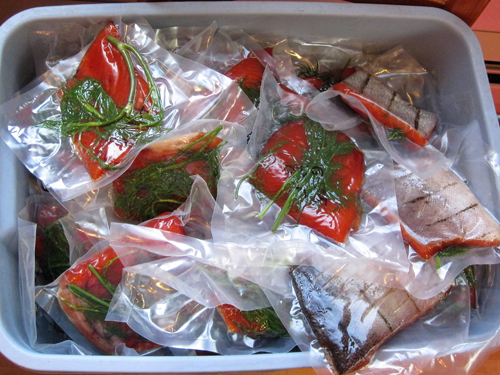
The Final Product, King Salmon Lox, vacuum-packed with fresh dill and ready to eat or freeze. |
• OPTIONAL
STEP: Before packing, you may wish to remove the pin bones
from each piece with a needle-nose pliers. The bones are easy to
spot, because
the flesh around them will have shrunk down. They pull out easily. Their
removal makes slicing the lox a bit easier, although the pin bones
are very fine and
will slice through if you leave them in. For "presentation lox" I
always remove the pin bones, but for our family's own consumption, I leave
them in because their removal is time-consuming.
• NOTE: Unlike
frozen fresh fish, which, even when vacuum-packed, goes "off" in six months at the
most, frozen, vacuum-packed lox will endure for up to three years in a freezer
that holds temperatures at or below 0° F.
More
on Alaska Salmon
Alaska
Salmon, of which there are 5-1/2 species, comprise one of the most valuable
fishery resources of the United States. The "1/2" species refers
to steelhead trout, which are similar to Atlantic salmon.
Chinook
or King: Soft
in texture, very rich in oil, and separates into large flakes, making it
excellent
for salads and recipes calling for large pieces. "Small" kings
are 20 lbs, 30 lb kings are common. One sub-species of King, that return
to the
Kenai River, can be gigantic: the record stands at 97 lbs!
Sockeye
or Red: Has deep red meat, is of firm
texture, and breaks into smaller flakes, making it attractive for hot dishes
and salads.
Coho
or Silver: Is large-flaked, a lighter red than sockeye, and is
good in all dishes. Excellent for Lox, as its fat content is second only to Kings.
Pink
or Humpy: Smallest and least interesting of the species; light
pink flesh, extensively used for canning.
Chum
or Dog: Is
large-flaked, pearly-pink in color, low in oil, less strongly-flavored than
the other four species and is especially suitable for cooked dishes where
color is not important. Its large, pale eggs are considered by some to be the best for making salmon caviar ("Keta Caviar").

A 5-Star Mexico Pacific Coast Rental Villa
home | meat grinders | sausage
stuffers | sausage casings | e-mail
SausageMania | NEW! Sausage Photo
Tutorial | sausageMania recipes |more
SausageMania recipes | motorize
a grinder | tips | links | kippermania | loxmania | NEW! PestoMania | NEW! Even MORE SausageMania Recipes! | NEW! Lox Making Photo Tutorial | NEW! CaviarMania | NEW! Porcini Sausage!

